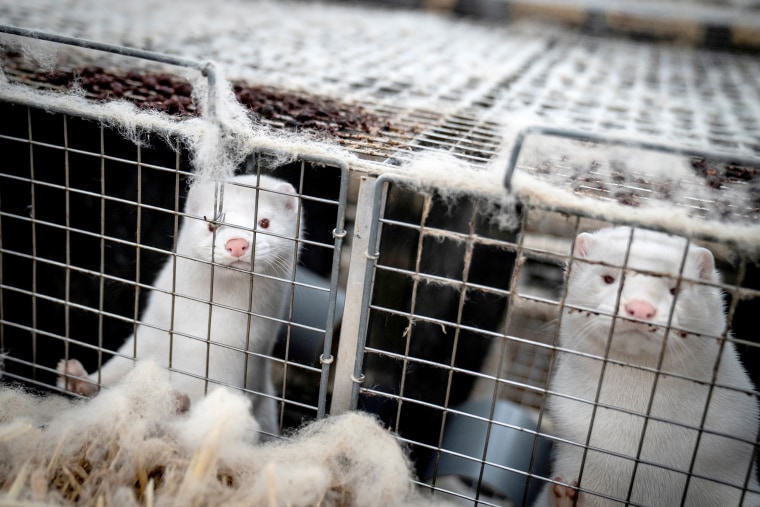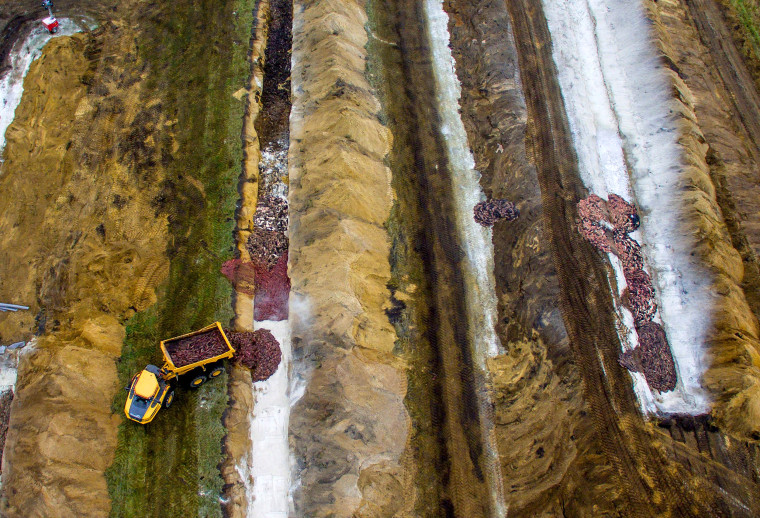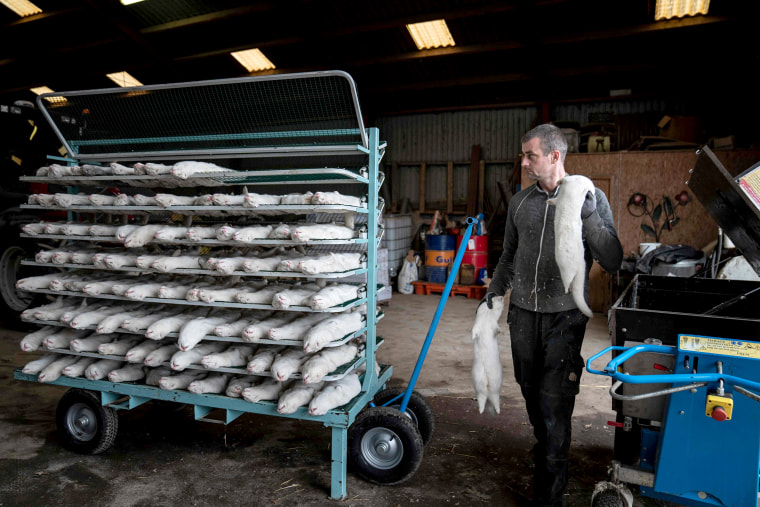Around the world, minks are getting sick.
The small, ferret-like mammals farmed for their valuable fur have raised alarm after contracting and mutating the coronavirus, passing it back to humans.
The virus, officials said, spread from human handler to mink, mutated, and then spread back to humans.
Denmark went so far as to cull 17 million minks in November in response to outbreaks at more than 200 mink farms. The northern region of the country, where most fur farms lie, was placed under strict lockdowns.
The Danish government spared no mink, killing infected and healthy animals, alike.
"We would rather go a step too far than take a step too little to combat Covid-19,” the country’s foreign minister Jeppe Kofod said at a press conference in early November. The country's prime minister later apologized and its food and agriculture minister stepped down when the order to kill the animals was declared illegal.
The story, however, has not ended there.
Since the mass slaughter, hundreds of mink carcasses have emerged from their graves.
Buried in shallow pits and trenches in Western Denmark, the dead minks were pushed out of the ground by gas emitted from their decomposing bodies, leading to more outrage and concern.
And across the Atlantic, mink farms in the U.S. are seeing Covid-19 spread and deaths of their own.
Here’s what’s going on.

Why are minks getting Covid-19 in the first place?
We know Covid-19 came from an animal host, and spilled into humans recently, said Jonathan Runstadler, professor in the department of infectious disease and global health at the Tufts University Cummings School of Veterinary Medicine. “That would lead one to think that the virus has retained the capability of replication and infection in other animal hosts as well.”
Runstadler, who studies emerging diseases in animals, said the outbreak in minks hasn’t surprised many in his field, in part because of the conditions in which they live.
At fur farms, minks are densely packed in conditions ripe for close contact with one another. Those conditions might be ideal for shoving the small mammals into metal machines that skin them for fancy coats and hats, but they also can be breeding grounds for the coronavirus.
Runstadler said it’s hard to know if minks are unique among other species in their ability to contract and spread the virus, or if they’re just in a situation that leads to such outbreaks.
What is known, though, Ontario Veterinary College professor Scott Weese said, is that viruses don’t automatically work their way into cells. They need to stick onto something.
“We have viruses that are just human viruses or dog viruses or cat viruses,” he explained. “This virus attaches well to mink. It’s a very good match.”
It also attaches pretty well to cats, but not as well to dogs and cows, he said. Still, we don’t know much about how it works in minks or other animals, in part because scientists have been busy trying to figure out how Covid-19 affects humans. But we do know a few things that are raising eyebrows.
Minks that catch Covid-19 are sometimes spreading a mutated form of the virus back to humans.
“Transmission back to people is more a concern at a personal level,” Weese said. “Big picture, it’s not probably a big deal because few people have contact with minks.”
When outbreaks occur at farms, local health departments are mandating quarantines. In northern Wisconsin, two farms in Taylor County are currently under quarantine after recent outbreaks killed 5,500 minks. The animals can’t move on or off the farm, said Kevin Hoffman, the public information officer for Wisconsin’s Division of Animal Health.
Hoffman said the outbreaks are under control. His department is helping the farms compost the mink bodies, and there are currently no conversations in the state about mass culling.
Still, “we’re definitely concerned,” Hoffman said, adding farmers are recommended to interact with mink the way they would humans during a pandemic: wearing proper PPE and keeping their distance.
There is also some worry that a mutated form of the virus, given to humans by minks, could make it more difficult to implement an effective vaccine.
“There is still some debate over whether it's a relevant change, and there’s not a clear answer on that,” Weese said.
It’s why both Weese and Runstadler say more studying needs to be done to understand Covid-19 in minks.
“I worry we are not doing enough to monitor that situation to make sure this virus isn’t spilling into the animal populations,” Runstadler said. “We should be identifying the interfaces where humans and animals are in close and frequent enough contact that virus spillover is possible, and doing surveillance.”
At fur farms, scientists have seen Covid-19 transfer from minks to cats through mink manure, and are worried about what would happen if it gets into wildlife populations.
“The other area to be concerned about is having this virus spill into an animal host that becomes a regional or local reservoir for viral infections,” Runstadler said.
Zombie Minks
The decision to cull the minks was a drastic one.
“The easiest way to get rid of a problem is to get rid of the problem,” Weese said, “but that’s not always the best way.”
Part of the problem, he explained, is that we don’t know the effects of the spread. If farms with outbreaks were isolated, it’s not known whether the virus would circulate through all the minks and eventually die out.
“We want to keep this a human virus,” Weese said. Culling is often the answer when data on animal spread is inconclusive. “When you’ve got a disease that is killing lots of people, there is less willingness to be lax with the animal side,” he said. Plus, people don’t have the close attachment to minks they might dogs. If the animal isn’t a common pet or an endangered zoo animal, there’s less outrage when it’s killed.

But Denmark’s decision was not without detractors. Outrage fomented in Denmark after images and videos of botched killings and mass mink graves circulated, and farmers spoke to the hardship this would cause them.
"We have 65,000 mink. In the coming week all will be put down," Danish mink farmer Martin From told the BBC in November. “This will end our business.”
Danish Prime Minister Mette Frederiksen apologized for the killing, tearing up as she called it a “regrettable mistake” and admitting the government did not have the legal jurisdiction to cull so many animals.
News of “zombie minks,” pushed up from their shallow and quickly built graves by the gas created from their decomposing bodies, has only furthered anger.
Denmark's government wants to dig up some of the culled minks from the mass graves.
For animal rights groups, the debacle illustrates why fur farming should be eliminated.
“With or without a cull, the animals on these farms would still be violently killed at some point,” Ashley Byrne, an associate director at PETA, said. “These Covid-19 outbreaks and the grisly circumstances that have gone along with them in the mink industry are just more evidence that the fur industry needs to be finished.”
Byrne called the farms a “recipe for a disaster” in a pandemic, stressing fur farms put humans at risk, too.
But Marc Kaufman, a fur merchant in New York City who sells a lot of mink coats, said there is no reason for his industry to worry about the outbreaks.
“Water rises all,” he said. “With furs, if it’s not made one place, it’s made some place else. Demand is there, and need for the product is there. If Copenhagen doesn’t farm the skins, Russia will. If Russia doesn’t, China will. Either way there is gonna be a supply because there is demand.”
Kaufman, whose family has been in the business since 1870, said his shop is busier this year than last, and customers aren’t talking about the minks getting Covid-19.
“They put down cows when they have cow disease, they put down chickens when they have salmonella, this isn’t the first time animals have been killed for disease purposes. Things happen.” he said. “When it gets cold, people need fur.”

